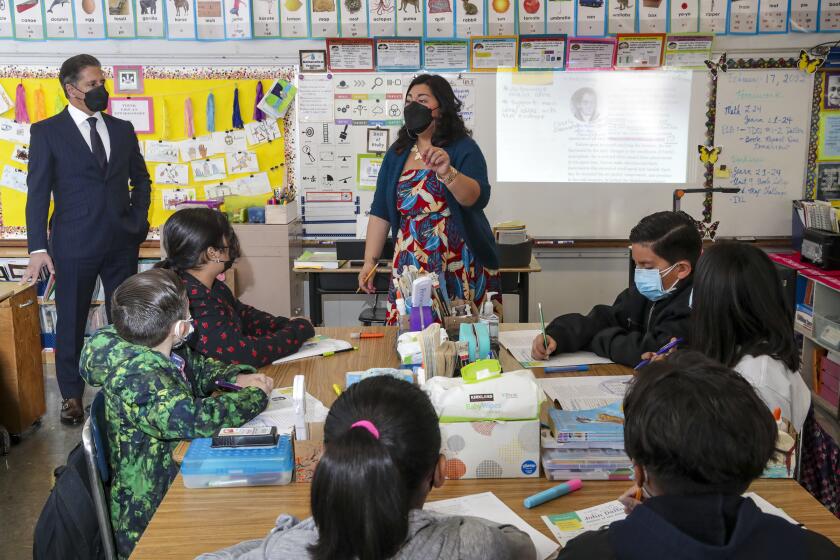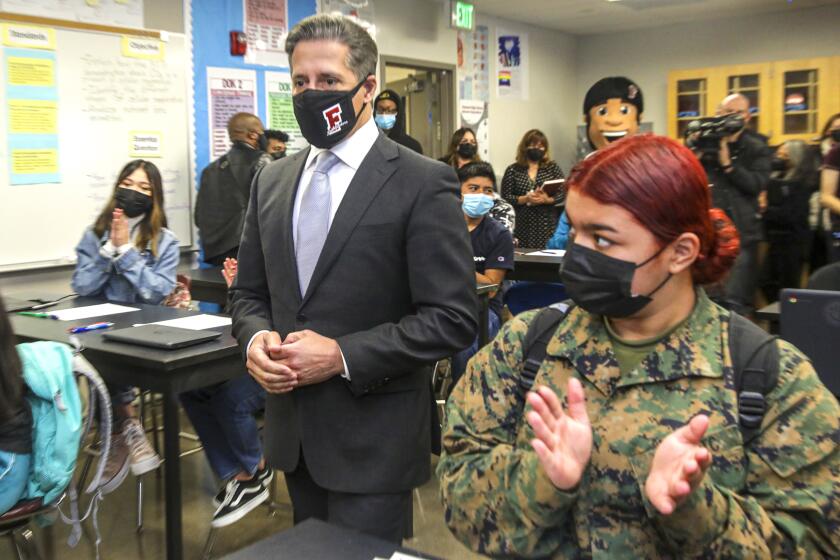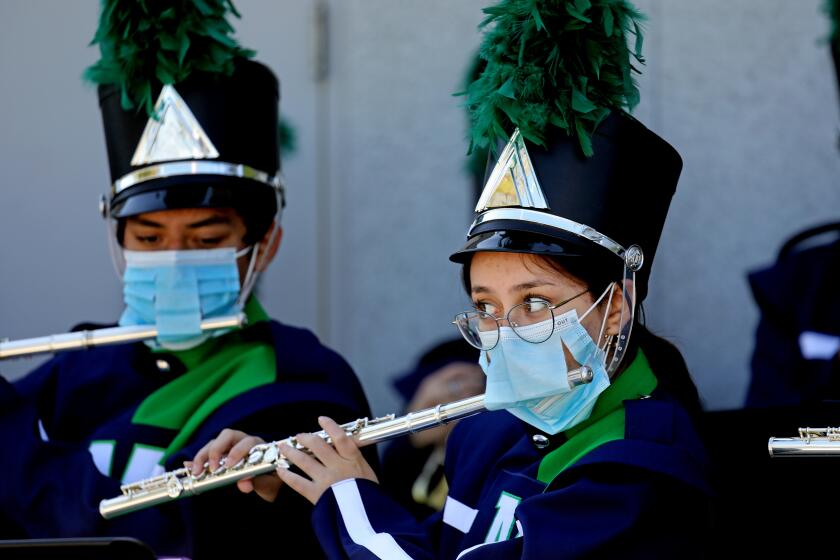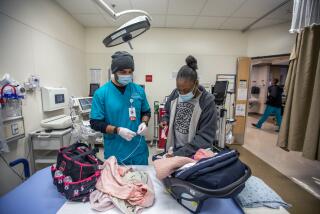Is it safe to lift indoor mask rules at California schools? Here’s what health experts say
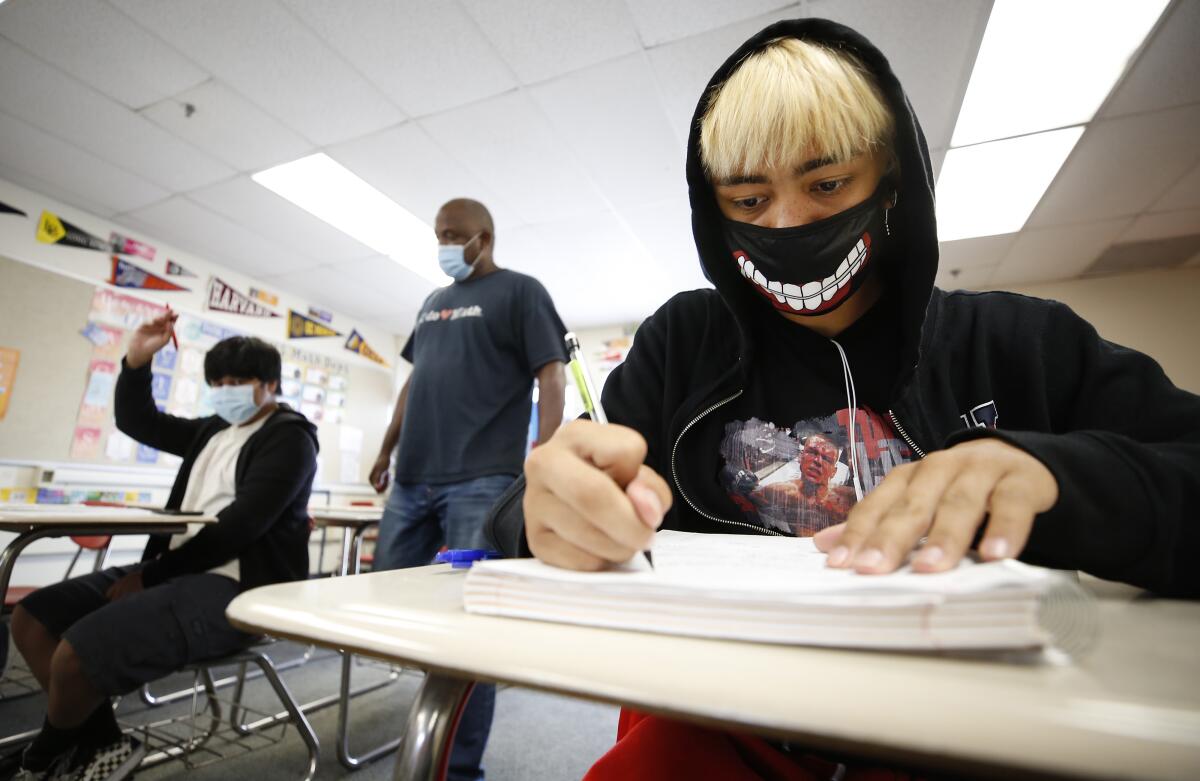
Public health officials say California’s strict coronavirus policies in schools in recent months have resulted in relatively few pandemic-related campus closures.
Moreover, California’s rates of pediatric COVID-19 hospitalizations are the lowest among the nation’s six most populous states, health experts said.
So why have they decided to lift a statewide mask rule in K-12 schools after March 11, allowing schools to decide for themselves?
Here’s what we know:
Local officials will retain the option of keeping mask rules in place. More than 1,000 school districts face making their own decisions on when to take that step — contingent on health orders and labor agreements.
State officials say it’s now safer
One of California’s top health officials said the falling coronavirus numbers justify the relaxing of the rules.
“This feels like the right time. There’s the data that supports it,” both in terms of declining coronavirus cases and impacts on hospitals, Dr. Mark Ghaly, California’s health and human services secretary and a pediatrician, said Monday.
But Ghaly said state officials are still “strongly recommending” mask wearing in K-12 schools, rather than simply advising it or making it optional.
“This is because we are coming out of what was one of the most devastating surges that we experienced as a state — where healthcare systems are still reeling, where they aren’t quite 100% back to their baseline,” Ghaly said.
“There’s a lot of members of our community who still are at risk,” he added. “There are children who are not eligible for a vaccine yet — those kids under the age of 5. We have individuals who are disabled, those who are older, who have, yes, been boosted and been vaccinated but still carry a significant degree of risk,” Ghaly said.
There’s also a concern about lower vaccination rates among younger children.
Only 30% of California’s children age 5 to 11 are considered fully vaccinated, whereas 65% of adolescents age 12 to 17 are. By contrast, 77% of adults up to age 49 are fully vaccinated, and more than 82% of older adults are.
Many health experts are strongly recommending the public still wear masks even as the state lifted its order requiring them to be worn in indoor public spaces for vaccinated people.
Experts have mixed feelings
UC Berkeley infectious diseases expert Dr. John Swartzberg was critical of moving too rapidly to ease the K-12 mask mandate.
Swartzberg said he thought the state’s plan was reasonable, but it would have been better to retain the mask mandate until cases dropped lower — suggesting a threshold of less than 35 coronavirus cases a week for every 100,000 residents, which, on a statewide basis, is less than 2,000 cases a day.
He thought the timing of the new guidelines has been influenced by a loud minority of those opposed to COVID-19 mandates for schools. A recent poll conducted by UC Berkeley’s Institute of Governmental Studies and co-sponsored by the L.A. Times found that that nearly 2 in 3 California voters support mask and vaccine mandates in K-12 schools.
Swartzberg pointed to California’s decision to lift its universal indoor mask mandate in mid-June — about a month after many other states did. Ensuring case rates were lower before mask rules were eased led to California suffering a much less severe summer Delta wave because its overall case count was lower before the new variant hit, which saved more people from severe illness and death, Swartzberg said.
“Everybody says we’re following the science. I think that’s true. But people are also following other things [including] the psychology of a minority of people — but a large minority of people — who are very vocal about removing masks in children,” he said, adding that he’s skeptical of claims suggesting children don’t learn as well in classrooms with universal masking.
“I’d certainly prefer children not having a mask on. There is something lost there, probably not very great,” Swartzberg said, referring to the students’ educational experience when everyone wears masks.
But not requiring masks when coronavirus transmission levels are elevated also risks children’s safety, he said. He also feared children in schools that have less resources, such as those with poor ventilation, will be at greater risk.
“There is a real risk from COVID — albeit small. Why take it if we don’t have to, until we know we’re at a time when there are very few cases around?” Swartzberg said.
Dr. Robert Kim-Farley, a medical epidemiologist and infectious diseases expert at the UCLA Fielding School of Public Health, said it’s reasonable for L.A. County to still strongly recommend masking requirements at K-12 schools and childcare sites when mandates are lifted on March 12.
If improving trends continue, Kim-Farley said he expected “there will be a time when they will say that we’re no longer needing to recommend masks in schools.” But it’s also important to be flexible, and should there be another curveball by a new variant, there could be a need to return to universal mask requirements.
Although L.A. County school systems can soon end masking, L.A. Unified may need a go-ahead from its teachers union.
COVID-19 in retreat
One main reason for the easing of mask requirements in K-12 schools is California’s plummeting coronavirus case rate. In mid-January, the state was recording about 123,000 coronavirus cases a day, far worse than last winter’s peak of 46,000 cases a day.
But by the first week of February, the state was averaging about 33,000 cases a day, and most recently, roughly 10,000 cases a day. By March 11, state officials forecast California could be averaging 2,000 to 6,000 cases a day, according to data Ghaly provided.
California at less than 2,800 cases a day would be considered in the “moderate” level of transmission, which is less than 50 cases a week for every 100,000 people.
Getting under that number would represent a significant milestone under older, stricter criteria established by the U.S. Centers for Disease Control and Prevention — which, until Friday, was the threshold the agency used to ease universal masking recommendations. California last consistently got to this level between April and July 2021, before the summer Delta surge struck.
The CDC on Friday issued new recommendations. Many counties in Southern California now fall into a “medium” transmission level, including Orange, Riverside, San Bernardino, Ventura and Santa Barbara. In those areas, the CDC no longer recommends universal masking in K-12 schools but says at-risk people may choose to wear them.
The CDC was still recommending that L.A. County practice universal masking in schools because of its high transmission level as of Friday. Similar recommendations were in place in San Diego and Imperial counties as well as parts of the San Joaquin Valley and rural Northern California. It’s likely, however, that Los Angeles County will likely fall into a medium level later this week.
In addition, the impacts on California’s hospitals from the Omicron surge are easing. The number of coronavirus-positive patients hospitalized in California are about one-quarter of what they were at the height of the Omicron surge — there were 4,233 hospitalized as of Sunday, a fraction of this winter’s peak of 15,435 recorded on Jan. 21. Coronavirus-positive hospitalizations are at their lowest levels since around Christmas.
In addition, the number of pediatric coronavirus-positive hospital patients has dropped by half in the last two weeks, from about 1,000 to 500, according to data provided by Ghaly.
Officials said masks will be strongly recommended — but no longer required — for unvaccinated individuals in most indoor settings starting Tuesday.
What will happen at my school?
The decisions on whether schools will retain indoor mask mandates in K-12 settings will now fall to districts and private schools. The Los Angeles County and San Francisco public health departments, for instance, have said they will allow school operators to make those decisions.
The L.A. County Department of Public Health said in a statement it was “strongly recommending indoor masking requirements at childcare sites and K-12 schools beginning March 12.” The San Francisco Department of Public Health said it “strongly recommends that all individuals in schools and childcare continue to wear masks for the time being to keep an added layer of protection and minimize disruptions to in-person learning.”
Ghaly said local school officials should make their own decisions to retain mask mandates if they thought it would be prudent. “Districts ... should feel empowered to keep masking in place,” he said. “As somebody who’s stood for supporting Californians’ health, that’s a very reasonable decision to make.”
Some who have grown tired of masking requirements welcomed the state’s relaxation announced Monday.
“As the Omicron surge continues to decrease in L.A. County, we need to implement flexible COVID-19 infection control policies and move away from rigid approaches. The time for compulsory masking mandates has come to an end,” Supervisor Kathryn Barger said in a statement. Decisions about masking mandates in schools “should be made based on local data, along with parent and staff input.”
Times staff writers Howard Blume and Paloma Esquivel contributed to this report.
More to Read
Start your day right
Sign up for Essential California for news, features and recommendations from the L.A. Times and beyond in your inbox six days a week.
You may occasionally receive promotional content from the Los Angeles Times.
